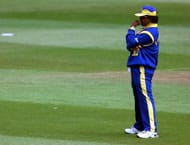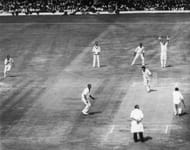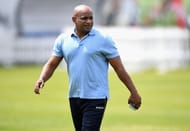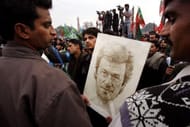The holistic nature of cricket as a sport and the inclusion of umpteen elements in the course of each game of it, let alone a cricketer's lifetime, has always inculcated in the involved players' admirable qualities of delegation and responsibility. This particular reason has led to a lot of cricketers taking up administrative roles in their professional lives after they have had enough of the on-field action.
Lots of Australian upper tier leaders have been known to be cricket tragics, the sight of Bob Hawkes sculling his glass of beer is one of the most popular and applause triggering sights across stadia in all of Australia, bet it a parched afternoon in the wild wild west of Perth, or the social event of the year in South Australia, that is the soothing day-night Test match at Adelaide.
Here we look at some cricketers who turned into political leaders while batting in the second dig of their careers.
#5 Navjot Singh Sidhu

One of the most popular figures across the widened spectra of Indian television, Sidhu has always stood out, be it his Jekyll-Hyde brand of batting, blocking for hours and then launching into a flurry of aerial marked shots, or be it his colorful character-smeared speeches.
After retiring from his cricketing travails, that were the most known for the takedown of the then hyped Shane Warne, Sidhu found an affiliation with the Bhartiya Janta Party in 2004. But a court case against him meant that he had to wait for another five years to get his maiden general elections victory, and after years of campaigning to change Amritsar for the better, he was elected the Member of Parliament.
However, since then, his career has often seemed rather fluctuating, from not getting a ticket from BJP in 2014 to being inducted to Rajya Sabha in 2016 to avoid him from joining the Aam Aadmi Party, a decision that was soon defied by Sidhu himself. So far, his political stroke making has been surprisingly close to the one he displayed on the cricket wicket.
#4 Arjuna Ranatunga

The original Captain Cool, Ranatunga was responsible for Sri Lanka's first mark of authority as a major cricket nation on the global landscape, as he led them to an emphatic win over the favorites Australia in the 1996 World Cup final. In a career spanning close to two decades, he was with Sri Lanka from their inaugural Test to the time they became a serious force to reckon with.
Ranatunga's impeccable captaincy skills meant that he was a popular figure among all strata of people back home and with a father for a politician, it was always meant to be for him.
He entered into politics by joining the Sri Lanka Freedom Party led by Chandrika Kumaratunga and had a shot at a greater leadership role he had held all his life by contesting the 2001 parliamentary elections with PA from Colombo District. After the UPFA victory in 2004, he was appointed Deputy Minister of Industry, Tourism and Investment Promotion.
Like Sidhu, Ranatunga has also had his loyalties constantly shifting, leaving the UPFA and joining the Democratic Party of the DNA in 2010. Two years later came an exit from the Democratic Party and the association with DNA remained intact.
#3 Wes Hall

The legendary Caribbean fast bowler was the benchmark for what every aggressive paceman aspired to be in that era. Towering at 1.96 m, his run into the batsman was a sight to behold and as he went into his swift stride to release the ball, often at stratospheric velocities (the lack of speed guns spared the batsmen from knowing what they were against) led to batters perishing to him 192 times.
He led the fearsome West Indian bowling attack in only his second Test match and decimated the hosts India with a bag of eleven intimidating dismissals. But opposed to a tough exterior, was a man who wanted to serve the public.
After retirement, he indulged in revolutionary voluntary work in troubled neighborhoods and was responsible for what SEVROL is today, functioning across all of Trinidad and Tobago.
First involved in administration roles with West Indian cricket as selector, manager and director on different occasions, he became involved in Barbadian politics, joining the Democratic Labour Party. At first, he got induction into the Barbados Senate, Hall was later elected to the House of Assembly.
He also found himself representing the Assembly constituency of St. Michael West Central in 1986 and re-elected in 1991. In 1987 Hall was appointed Minister of Tourism and Sports in the Government of Barbados.
#2 Sanath Jayasuriya

Often credited with changing how one-day cricket was played, Jayasuriya ended his career, as without a doubt one of the greatest cricketers of all time, entertaining with his trademark gigantic strokes over point played with arrogant nonchalance, providing a brilliant all-round balance to his side over the years contributing in Sri Lanka's major success and a delightful sight to see in the bunch of trump cards in your hands.
After an illustrious cricket career, he also went on to engrave his name in the political arena. Always known for his feisty personality and imposing temperament, like Ranatunga, Jayasuriya has enjoyed the support of public over the years.
He entered politics in February 2010 as a candidate for Matara District. His party is the United People's Freedom Alliance (UPFA) of president Mahinda Rajapaksa, securing the most number of preferential votes from the Matara District by reeling in 74,352 votes. He was also appointed as a UN Goodwill Ambassador (by UNAIDS, Geneva) for his commitment to prevention of HIV/AIDS among young people in Sri Lanka.
In October 2013, he was appointed as deputy minister of Postal services in the UPFA government, currently, he is serving as chairman of Sri Lankan cricket selectors succeeding from his role as a deputy minister prior to that.
#1 Imran Khan

Once you might have thought that shepherding his cornered tigers to eternal glory in 1992 would have been the highest point of Imran Khan's life, but he defied odds time and again, and against all struggles yet again, he ended up triumphing by recently being elected as the Prime Minister of Pakistan.
Imran Khan, who was one of the four great all-rounder of the eighties alongside the likes of Botham, Kapil Dev, and Hadlee, pioneered the art of reverse swing that revolutionized the way Pakistan played Test cricket.
Post-retirement, he formed the Pakistan Tehreek-e-Insaf (PTI). His political debut wasn't as fruitful as he unsuccessfully ran for the seat of National Assembly of Pakistan as a candidate of PTI from two constituencies - NA-53, Mianwali and NA-94, Lahore.
As Imran's power grew across the country, so did his ambitions. In 2013, he ran for Prime Minister, only to end up losing to Nawaz Sharif by a whisker of a margin. He had his share of controversy for inappropriate manner of his allegations while in the Opposition in 2013, then again in 2018 he had accusations against him for rigging the polls alongside media around the world bashing him for his chauvinistic remarks.
Nonetheless, contesting election from NA-61 (Rawalpindi-V) and NA-95 (Mianwali-I), Imran, once again like the cornered tiger, with his back against his wall, rose to prowl.
Looking for fast live cricket scores? Download CricRocket and get fast score updates, top-notch commentary in-depth match stats & much more! 🚀☄️
